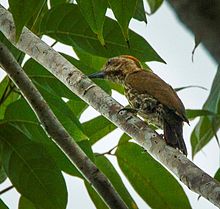Melancholy woodpecker
| Melancholy woodpecker | |
|---|---|

| |
| Illustration (right) with Gabon woodpecker (in front) | |
| Scientific classification | |
| Domain: | Eukaryota |
| Kingdom: | Animalia |
| Phylum: | Chordata |
| Class: | Aves |
| Order: | Piciformes |
| Family: | Picidae |
| Genus: | Dendropicos |
| Species: | D. lugubris |
| Binomial name | |
| Dendropicos lugubris Hartlaub, 1857 | |
| Synonyms | |
| |
The melancholy woodpecker (Dendropicos lugubris) is a species of woodpecker. It is found in West Africa from Sierra Leone east to Nigeria, living in forests, forest edges, clearings and woodlands. It is sometimes considered to be a subspecies of the Gabon woodpecker. The International Union for Conservation of Nature has assessed it as a least-concern species.
Taxonomy
This species was formally described by the German ornithologist Gustav Hartlaub in 1857.[2] The species is monotypic. It was sometimes considered conspecific with the Gabon woodpecker, Dendropicos gabonensis, because D. gabonensis reichenowi is intermediate between the two species.[3]
Description

The melancholy woodpecker is 17–18 cm (6.7–7.1 in) long. The crown is olive-brown, and the nape is red in the male and blackish in the female.[4] The face is white and has an olive-brown malar, dusky ear coverts and a white supercilium.[5] The chin and throat are white and often have dark streaks or spots. The upperparts are bronzy-green. The flight feathers are brown, with greenish-bronze edges. The tail is black above and grey-black below. The underparts are greenish-yellow, with broad brown streaks.[4] The beak is greyish, the legs are olive or grey, and the iris is chesnut.[5] The juvenile bird is duller, and its upperparts do not have a bronze tone.[4]
Distribution and habitat
This woodpecker is found in the Upper Guinean forests of West Africa,[5] in Cameroon, Ivory Coast, Ghana, Guinea, Guinea-Bissau, Liberia, Nigeria, Sierra Leone and Togo.[1] Its habitat is open forest, forest edges, clearings, secondary forest and woodlands, up to 1,200 m (3,900 ft) in elevation.[4] It is also found in swamps, plantations and gardens.[5]
Behaviour
The melancholy woodpecker eats insects in the canopy. It forages in families and joins mixed-species foraging flocks. It sometimes drums quietly and stridently. Its calls include a tinny trill, a series of rrek and rrak notes, b-ddddddd-d-it, br-r-r-r-r-r-r and zh-dzeeeep. It calls pit notes in disputes.[5] Breeding may occur from December to March.[4]
Status
The species has a large range and stable population, so the IUCN has assessed it as a least-concern species.[1]
References
- ^ a b c BirdLife International (2016). "Dendropicos lugubris". IUCN Red List of Threatened Species. 2016: e.T22680967A92888403. doi:10.2305/IUCN.UK.2016-3.RLTS.T22680967A92888403.en. Retrieved 20 November 2021.
- ^ Gill, F.; Donsker, D. (eds.). "Woodpeckers". IOC World Bird List Version 7.3. Retrieved 1 August 2017.
- ^ Winkler, H.; Christie, D. A. "Melancholy Woodpecker (Dendropicos lugubris)". In del Hoyo, J.; Elliott, A.; Sargatal, J.; Christie, D. A.; de Juana, E. (eds.). Handbook of the Birds of the World Alive. Lynx Edicions.
- ^ a b c d e Winkler, Hans; Christie, David A.; Nurney, David (2010). Woodpeckers. A&C Black. pp. 242–243. ISBN 9781408135037.
- ^ a b c d e Gorman, Gerard (2014). Woodpeckers of the World. A&C Black. p. 201. ISBN 9781408147177.

